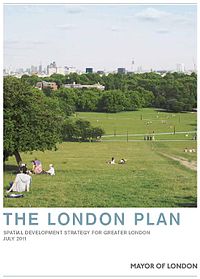Governance
The principal local authorities in the area are the London borough councils of Barking and Dagenham, Hackney, Havering, Newham, Redbridge, Tower Hamlets and Waltham Forest. The regional authority for all of Greater London is the Greater London Authority. As part of the sub-regional policy of the London Plan East London has been within a number of sub-regions for statutory monitoring, engagement and resource allocation. The current East London sub-region established in 2011 consists of Barking and Dagenham, Bexley, Greenwich, Lewisham, Hackney, Havering, Newham, Redbridge, Tower Hamlets and Waltham Forest. From 2008 to 2011 the North East sub-region comprised Barking and Dagenham, City of London, Havering, Newham, Redbridge, Tower Hamlets and Waltham Forest. From 2004 to 2008 the sub-region consisted of Barking and Dagenham, Bexley, City of London, Greenwich, Lewisham, Hackney, Havering, Newham, Redbridge and Tower Hamlets. 15 of the 73 London Parliamentary constituencies cover the area. The London Plan is the statutory spatial development strategy for the Greater London area in the United Kingdom that is written by the Mayor of London and published by the Greater London Authority.[1] The regional planning document was first published in final form on 10 February 2004. In addition to minor alterations, it was substantially revised and republished in February 2008[2] and again in July 2011.[3][4] The London Plan published in July 2011 is currently in effect and has 2031 as a formal end date. As of June 2012 minor alterations are being m

de to the plan in order to comply with the National Planning Policy Framework and other changes in national policy.Mandate The plan replaced the previous strategic planning guidance for London issued by the Secretary of State and known as RPG3. It is a requirement of the Greater London Authority Act 1999 that the document is produced and that it deals only with matters that are of strategic importance to Greater London. The Act also requires that the London Plan includes in its scope: the health of Londoners, equality of opportunity, contribution to sustainable development in the United Kingdom. Greater London is divided into five sub regions for the purposes of the London Plan. The boundaries of these areas were amended in 2008 and 2011 and their role in the implementation of the London Plan has varied with each iteration. From 2004 to 2008 the sub regions were initially the same as the Learning and Skills Council areas set up in 1999.[1] These 2004—2008 sub regions each had a Sub-Regional Development Framework.[2] The sub regions were revised in February 2008 as part of the Further Alterations to the London Plan.[3] The 2008—2011 sub regions, each had its own Sub Regional Implementation Framework.[4] In 2011 the sub regions were revised again. The 2011 sub regions are to be used for statutory monitoring, engagement and resource allocation. The administrative area, region and ceremonial county of Greater London, including the City of London, is divided into 73 parliamentary constituencies which are all borough constituencies.